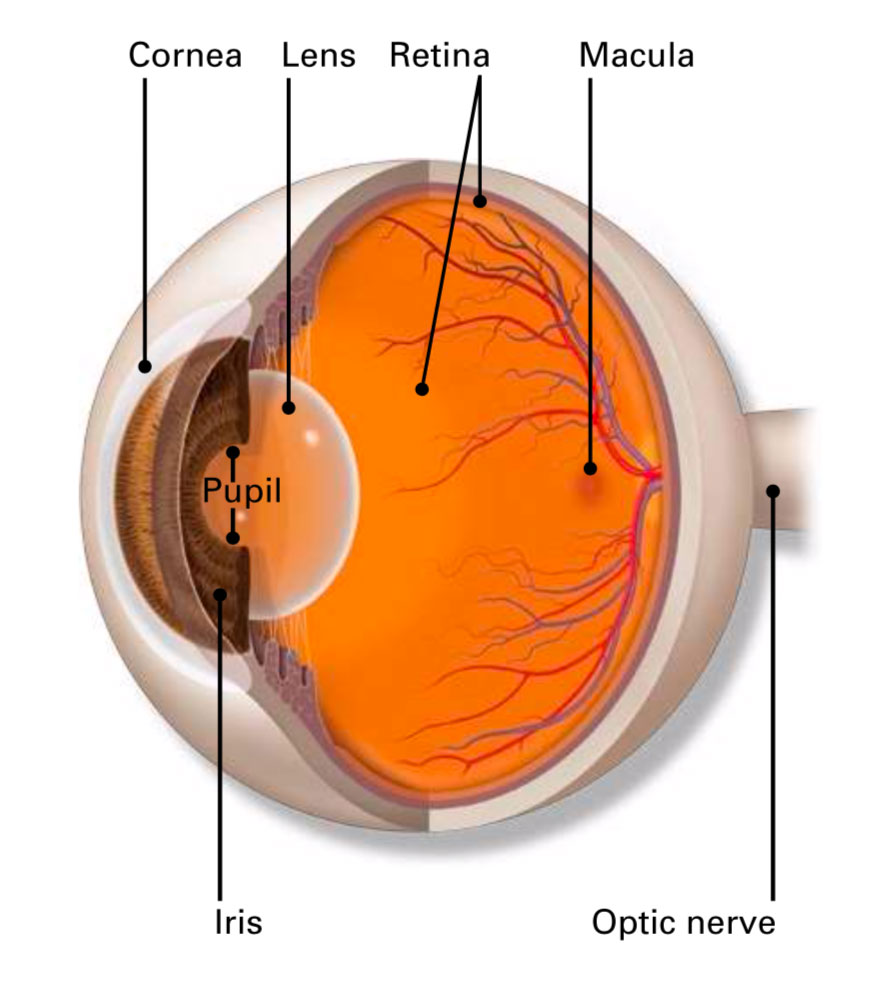AMD
Age-related Macular Degeneration
Age-related macular degeneration is unfortunately very common and it is a leading cause of vision loss in people over 50 years of age. Our eye surgeons provide patients with a personalised treatment plan, carefully explaining all options.

Image from American Academy of Ophthalmology: Cataract Surgery
What is age-related macular degeneration?
Age-related macular degeneration (AMD) is a sight-threatening condition that affects your retina (layer of light-sensitive nerve cells lining the back wall inside the eye, analogous to the film in a camera). In AMD, the macula or central part of the retina becomes damaged. The macula is the part of the eye that serves your central, high resolution vision, such as recognizing people’s faces or reading. Hence, when afflicted by AMD, you lose your central vision, but your peripheral (side) vision will still be normal.
What are the types of AMD?
It is not uncommon for patients to have both types of AMD in the same eye, or dry AMD in one eye and wet AMD in their other eye. Patients may initially start with dry AMD, which in the early stages may be asymptomatic, and then they may progress on to develop wet AMD.
1) Dry (or atrophic) AMD:
In dry AMD, there is “wear and tear” of the macula due to ageing changes and the macula gets thinner (atrophies) with age and tiny clumps of debris called “drusen” accumulate. This is the most common type of AMD, accounting for about 90% of all cases. There is slow, progressive and insidious loss of central vision with dry AMD. Unfortunately, there is currently no way to treat dry AMD yet but this is an area active medical research.
2) Wet (or neovascular) AMD:
A less common but much more serious and aggressive form of AMD. Wet AMD is characterized by the development of new, abnormal blood vessels that grow under macula. These blood vessels are fragile and consequently bleed easily, causing swelling of the macula. Wet AMD can present more acutely with recent onset of wavy, crooked or dark/blurry patch in the central vision. Wet AMD is the treatable form of AMD and hence prompt detection and referral to an ophthalmologist is critical. Without treatment, you may lose vision quickly and severely with wet AMD. Modern medical treatment for wet AMD is highly effective and successful in protecting vision.

With AMD, dark areas may appear in your central vision. This may affect your ability to recognise faces, to read, or watch the TV.
Who is at risk for getting AMD?
Risk factors for developing AMD include:
- Age over 50 years old
- Family history of AMD
- Cigarette smoking
- Eating a diet high in saturated fats (found in foods like meat, butter and cheese)
- Being overweight
How is AMD diagnosed?
With early AMD, there are often no symptoms and so many people don’t realise that they have AMD until their vision becomes very blurry. This is why it is important to have regular visits to an eye care professional, especially those aged over 50 years or where they have a known family history of AMD. Your eye specialist can look for early signs of AMD before you have any vision problems.
Your eye specialist can diagnose AMD by a comprehensive eye examination, which includes checking your central vision with visual acuity chart, an Amsler grid, and a retinal examination whereby pupil dilating eye drops are used and your specialist will look inside your eye through a special microscope. In addition to diagnosing the presence of AMD, your doctor can determine what type of AMD you may have as well as its severity and whether any treatment or lifestyle modification is advisable.
Depending on your macula condition, your eye doctor may recommend additional specialized retinal imaging tests. These include digital retinal photography, OCT macula scan, OCT angiography, fundus autofluorescence, or fluorescein retinal angiography. These are highly specialized retinal imaging technology and all of these are available at Eastwood Eye Specialists to ensure you receive the most accurate retinal diagnosis and treatment plan. Because of the complex nature of retinal conditions, it is important that your eye specialist has the necessary expertise in medical retina. Patients at Eastwood Eye Specialists can have the confidence that Dr John Chang has additional subspeciality fellowship training in the diagnosis and management of medical retina conditions.
How is AMD treated?
Dry AMD:
At present, there is no way to reverse the wear and tear damage that occurs in dry form of AMD. However, people with more severe grades of AMD or lots of “drusen” debris might benefit from taking a certain (AREDS) combination of vitamin supplements. A large medical research clinical trial called the “AREDS study” found that there is some benefit from taking these daily vitamins to reduce the progression of AMD and vision loss. The specific AREDS vitamin supplementation (daily dosage) consists of: vitamin C (500 mg), vitamin E (400 IU), Zinc (80 mg), Copper (2 mg), Lutein (10 mg), and Zeaxanthin (2 mg). It is best to have your macula examined and get appropriate personalized advice from your eye specialist, as not everyone benefits from these vitamins.
Wet AMD:
Being a treatable form of macula degeneration, wet AMD demands prompt diagnosis and early treatment is very important. Delay in treatment may result in vision loss. The main class of medications used to treat wet AMD are called “anti-VEGF” injections and the currently available ones in Australia are Lucentis, Eylea, Vabysmo, Beovu and Avastin. This medicine can only be delivered into your eye by an “intravitreal injection” using a very slender (tiny) needle. Naturally, most patients are nervous about such a procedure, however one can have the absolute confidence and reassurance that this is a very safe treatment that can be provided in the clinic procedure room. The eye is made numb by eye drops so that there is no pain and the procedure is very quick and you won’t be able to see the needle. Eastwood Eye Specialists has a purpose-built procedure room for this treatment with patient safety and comfort at the forefront of its design.
Anti-VEGF eye injections help reduce the leakage and bleeding from the abnormal blood vessels that have grown under the macula. These injections are highly effective in protecting your eye sight from wet AMD, with high success in preventing blindness and can even result in significant improvement in your vision. Dr Chang has performed tens of thousands of intravitreal injections.
Amsler Grid testing of your vision
The Amsler Grid is a useful tool that you can use for self monitoring at home that is simple and quick. This grid-like chart helps to monitor your central vision that is affected by AMD. Early on in its disease course, it may be difficult to notice the subtle changes in central vision from macular degeneration. Regular use of the Amsler grid can help you detect such early changes in central vision due to AMD as soon as possible, before it results in more advanced or severe symptoms. This is important because treating AMD early can help slow or stop further loss of sight. You should use an Amsler Grid every couple of days in the morning, as a regular habit. It is important to test one eye at a time and to follow the instructions on the chart. If you notice that any lines or parts of the grid look wavy, blurry or dim, please contact your eye specialist urgently.
AMSLER GRID
Download PDF.
For more information on age-related macular degeneration, please call Eastwood Eye Specialists for an appointment.